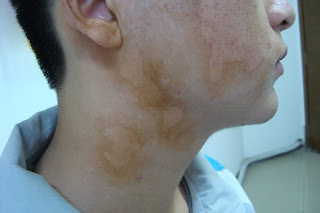Vitiligo is an acquired depigmenting disorder of the skin, in which pigment
cells (melanocytes) are lost. It presents with well-defined milky-white patches
of skin (leukoderma). Vitiligo can be cosmetically very disabling, particularly
in people with dark skin.
Vitiligo is due to loss or destruction of melanocytes, which are the cells that produce melanin. Melanin determines the colour of skin, hair, and eyes. If melanocytes cannot form melanin or if their number decreases, skin colour becomes progressively lighter.
People of all races are born with approximately the same number of pigment cells (melanocytes). The rate at which melanin granules are formed in these cells and their concentration in the epidermis are inherited characteristics and major factors in skin color differences. When no melanin is produced, the involved patch of skin becomes white. When a white patch grows or spreads, the cause may be vitiligo.
The exact cause of vitiligo is unknown. It is thought to be a systemic autoimmune disorder, associated with deregulated innate immune response, although this has been disputed for segmental vitiligo. There is a genetic susceptibility and vitiligo is a component of some rare syndromes. The gene encoding the melanocyte enzyme tyrosinase, TYR, is likely involved.
There are three theories on the cause of vitiligo:
The pigment cells are injured by abnormally functioning nerve cells.
There may be an autoimmune reaction against the pigment cells.
Autotoxic theory – the pigment cells self-destruct.
Current investigations are evaluating the pattern of cytokines (messenger proteins) and the role of the hair follicle in repigmentation.
Vitiligo is due to loss or destruction of melanocytes, which are the cells that produce melanin. Melanin determines the colour of skin, hair, and eyes. If melanocytes cannot form melanin or if their number decreases, skin colour becomes progressively lighter.
People of all races are born with approximately the same number of pigment cells (melanocytes). The rate at which melanin granules are formed in these cells and their concentration in the epidermis are inherited characteristics and major factors in skin color differences. When no melanin is produced, the involved patch of skin becomes white. When a white patch grows or spreads, the cause may be vitiligo.
The exact cause of vitiligo is unknown. It is thought to be a systemic autoimmune disorder, associated with deregulated innate immune response, although this has been disputed for segmental vitiligo. There is a genetic susceptibility and vitiligo is a component of some rare syndromes. The gene encoding the melanocyte enzyme tyrosinase, TYR, is likely involved.
There are three theories on the cause of vitiligo:
The pigment cells are injured by abnormally functioning nerve cells.
There may be an autoimmune reaction against the pigment cells.
Autotoxic theory – the pigment cells self-destruct.
Current investigations are evaluating the pattern of cytokines (messenger proteins) and the role of the hair follicle in repigmentation.







